英语培训学校工作计划表格(新版)
英语培训学校工作计划表格【精选】
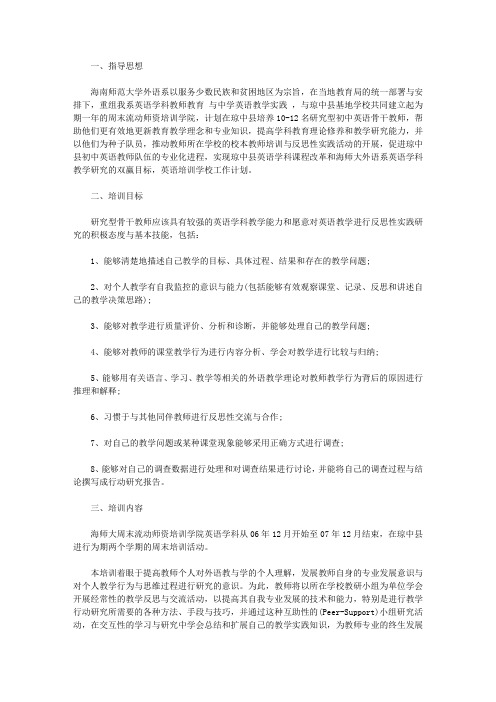
一、指导思想海南师范大学外语系以服务少数民族和贫困地区为宗旨,在当地教育局的统一部署与安排下,重组我系英语学科教师教育与中学英语教学实践,与琼中县基地学校共同建立起为期一年的周末流动师资培训学院,计划在琼中县培养10-12名研究型初中英语骨干教师,帮助他们更有效地更新教育教学理念和专业知识,提高学科教育理论修养和教学研究能力,并以他们为种子队员,推动教师所在学校的校本教师培训与反思性实践活动的开展,促进琼中县初中英语教师队伍的专业化进程,实现琼中县英语学科课程改革和海师大外语系英语学科教学研究的双赢目标,英语培训学校工作计划。
二、培训目标研究型骨干教师应该具有较强的英语学科教学能力和愿意对英语教学进行反思性实践研究的积极态度与基本技能,包括:1、能够清楚地描述自己教学的目标、具体过程、结果和存在的教学问题;2、对个人教学有自我监控的意识与能力(包括能够有效观察课堂、记录、反思和讲述自己的教学决策思路);3、能够对教学进行质量评价、分析和诊断,并能够处理自己的教学问题;4、能够对教师的课堂教学行为进行内容分析、学会对教学进行比较与归纳;5、能够用有关语言、学习、教学等相关的外语教学理论对教师教学行为背后的原因进行推理和解释;6、习惯于与其他同伴教师进行反思性交流与合作;7、对自己的教学问题或某种课堂现象能够采用正确方式进行调查;8、能够对自己的调查数据进行处理和对调查结果进行讨论,并能将自己的调查过程与结论撰写成行动研究报告。
三、培训内容海师大周末流动师资培训学院英语学科从06年12月开始至07年12月结束,在琼中县进行为期两个学期的周末培训活动。
本培训着眼于提高教师个人对外语教与学的个人理解,发展教师自身的专业发展意识与对个人教学行为与思维过程进行研究的意识。
为此,教师将以所在学校教研小组为单位学会开展经常性的教学反思与交流活动,以提高其自我专业发展的技术和能力,特别是进行教学行动研究所需要的各种方法、手段与技巧,并通过这种互助性的(Peer-Support)小组研究活动,在交互性的学习与研究中学会总结和扩展自己的教学实践知识,为教师专业的终生发展打好坚实的基矗四、培训与检测方式1、主题性集中培训每次集中培训都以一个教学主题为中心进行课堂教学分析与研讨活动,邀请本县全体初中英语教师共同参与,一方面有利于促进全县初中英语教师专业化的整体进程,同时为研究型骨干教师的专业发展提供良好的教师教育氛围与同伴教师之间相互支持和交流合作的人文环境。
英语培训学校工作计划表格

英语培训学校工作计划表格一、教学目标设定英语培训学校的教学目标是提高学生的英语语言能力,培养跨文化交流的能力,以及增强自主学习能力。
我们将根据学生的年龄层次和英语水平,设定明确的短期和长期目标。
短期目标注重提升学生的英语应用技能,如口语表达、听力理解、阅读理解和写作能力。
长期目标则侧重于培养学生的综合语言运用能力和跨文化交流能力,为他们未来的学习、工作和生活打下坚实的语言基础。
二、课程设置与安排我们将根据学生的需求和教学目标,设计多样化的课程,包括基础英语、口语实战、商务英语、雅思托福备考等。
课程安排将遵循由浅入深、循序渐进的原则,确保学生在不同阶段都能得到适当的挑战和提升。
同时,我们还将根据学生的学习进度和反馈,灵活调整课程内容和难度,以满足学生的个性化需求。
三、教学方法与手段在英语培训学校中,我们将采用多种教学方法和手段,包括情景教学、任务型教学、合作学习等,以激发学生的学习兴趣和积极性。
我们将充分利用现代教育技术,如多媒体教学、网络教学等,为学生提供丰富多彩的学习资源和互动平台。
同时,我们还将注重培养学生的自主学习能力,鼓励他们通过课外阅读、在线学习等方式,拓宽英语学习的视野和深度。
四、教学资源配备为确保教学质量,我们将投入大量资源,购买优质的教材和教具,建设完善的多媒体教室和网络学习平台。
我们还将与国内外知名教育机构合作,引进先进的教学理念和教学资源,不断提升学校的教学水平。
同时,我们还将定期更新教学设备和软件,以适应英语教学的新趋势和新要求。
五、师资队伍建设优秀的教师是教学质量的保障。
因此,我们将注重师资队伍的建设和管理。
我们将聘请具有丰富教学经验和专业知识的教师,为他们提供持续的职业发展机会和培训资源。
我们还将建立严格的教师评估和激励机制,鼓励教师不断创新教学方法和手段,提高教学效果。
同时,我们还将营造积极向上的教师团队氛围,促进教师之间的交流和合作。
六、学生管理与评估我们将建立完善的学生管理体系和评估机制。
英语培训学校周计划
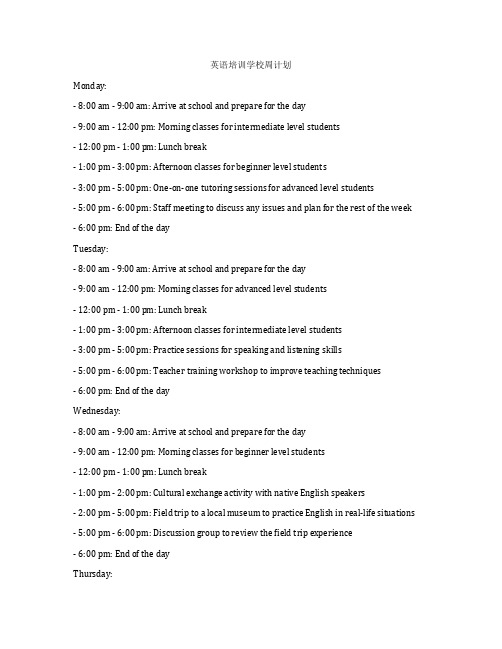
英语培训学校周计划Monday:- 8:00 am - 9:00 am: Arrive at school and prepare for the day- 9:00 am - 12:00 pm: Morning classes for intermediate level students- 12:00 pm - 1:00 pm: Lunch break- 1:00 pm - 3:00 pm: Afternoon classes for beginner level students- 3:00 pm - 5:00 pm: One-on-one tutoring sessions for advanced level students- 5:00 pm - 6:00 pm: Staff meeting to discuss any issues and plan for the rest of the week - 6:00 pm: End of the dayTuesday:- 8:00 am - 9:00 am: Arrive at school and prepare for the day- 9:00 am - 12:00 pm: Morning classes for advanced level students- 12:00 pm - 1:00 pm: Lunch break- 1:00 pm - 3:00 pm: Afternoon classes for intermediate level students- 3:00 pm - 5:00 pm: Practice sessions for speaking and listening skills- 5:00 pm - 6:00 pm: Teacher training workshop to improve teaching techniques- 6:00 pm: End of the dayWednesday:- 8:00 am - 9:00 am: Arrive at school and prepare for the day- 9:00 am - 12:00 pm: Morning classes for beginner level students- 12:00 pm - 1:00 pm: Lunch break- 1:00 pm - 2:00 pm: Cultural exchange activity with native English speakers- 2:00 pm - 5:00 pm: Field trip to a local museum to practice English in real-life situations - 5:00 pm - 6:00 pm: Discussion group to review the field trip experience- 6:00 pm: End of the dayThursday:- 8:00 am - 9:00 am: Arrive at school and prepare for the day- 9:00 am - 12:00 pm: Morning classes for advanced level students- 12:00 pm - 1:00 pm: Lunch break- 1:00 pm - 3:00 pm: Afternoon classes for intermediate level students- 3:00 pm - 5:00 pm: Practice sessions for writing and reading skills- 5:00 pm - 6:00 pm: Presentation by a guest speaker on English-speaking cultures and traditions- 6:00 pm: End of the dayFriday:- 8:00 am - 9:00 am: Arrive at school and prepare for the day- 9:00 am - 12:00 pm: Morning classes for beginner level students- 12:00 pm - 1:00 pm: Lunch break- 1:00 pm - 3:00 pm: Afternoon classes for advanced level students- 3:00 pm - 5:00 pm: Movie screening of an English-language film with discussion and analysis- 5:00 pm - 6:00 pm: Weekly assessment and feedback session with students- 6:00 pm: End of the daySaturday:- 9:00 am - 12:00 pm: Weekend workshop for all levels to focus on specific language skills - 12:00 pm - 1:00 pm: Lunch break- 1:00 pm - 3:00 pm: Mock English proficiency exams for students to assess their progress - 3:00 pm - 4:00 pm: Closing ceremony for the week with awards and recognition for outstanding students- 4:00 pm: End of the weekSunday:- Closed for the day, allowing for rest and relaxation before the start of the new week This weekly plan for an English training school aims to provide a well-rounded and immersive learning experience for students of all levels. Through a combination ofstructured classes, practical activities, and cultural experiences, students are given the opportunity to develop their English language skills in a dynamic and engaging environment. The inclusion of field trips, workshops, and guest speakers adds depth and variety to the curriculum, allowing students to apply their learning in real-world scenarios and gain a deeper understanding of English-speaking cultures. The weekly assessment and feedback sessions also provide valuable insights for both students and teachers, enabling continuous improvement and development. Overall, this weekly plan reflects the English training school's commitment to providing high-quality education and support for its students.。
英语培训机构工作计划模板
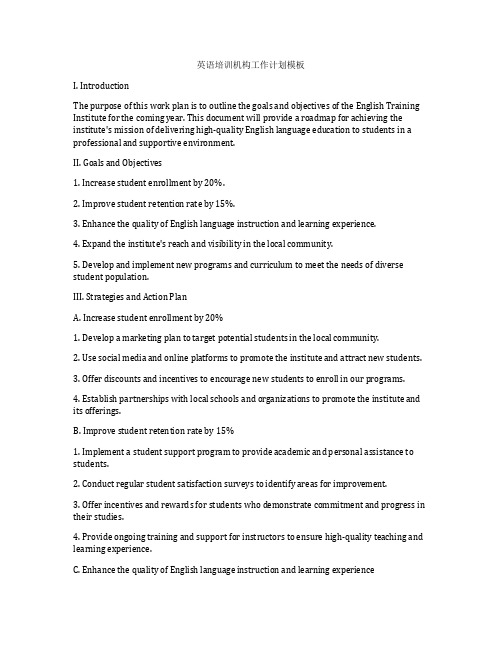
英语培训机构工作计划模板I. IntroductionThe purpose of this work plan is to outline the goals and objectives of the English Training Institute for the coming year. This document will provide a roadmap for achieving the institute's mission of delivering high-quality English language education to students in a professional and supportive environment.II. Goals and Objectives1. Increase student enrollment by 20%.2. Improve student retention rate by 15%.3. Enhance the quality of English language instruction and learning experience.4. Expand the institute's reach and visibility in the local community.5. Develop and implement new programs and curriculum to meet the needs of diverse student population.III. Strategies and Action PlanA. Increase student enrollment by 20%1. Develop a marketing plan to target potential students in the local community.2. Use social media and online platforms to promote the institute and attract new students.3. Offer discounts and incentives to encourage new students to enroll in our programs.4. Establish partnerships with local schools and organizations to promote the institute and its offerings.B. Improve student retention rate by 15%1. Implement a student support program to provide academic and personal assistance to students.2. Conduct regular student satisfaction surveys to identify areas for improvement.3. Offer incentives and rewards for students who demonstrate commitment and progress in their studies.4. Provide ongoing training and support for instructors to ensure high-quality teaching and learning experience.C. Enhance the quality of English language instruction and learning experience1. Develop and implement a standardized curriculum and teaching methodology for all programs.2. Update and upgrade teaching materials and resources to ensure relevance and effectiveness.3. Offer professional development opportunities for instructors to improve their teaching skills and knowledge.4. Provide a supportive and inclusive learning environment for students to thrive and succeed.D. Expand the institute's reach and visibility in the local community1. Participate in local events and fairs to promote the institute and its programs.2. Collaborate with other educational institutions and organizations to expand the institute's network.3. Conduct outreach activities to engage with potential students and their families.4. Utilize digital marketing strategies to increase the institute's online presence and visibility.E. Develop and implement new programs and curriculum1. Conduct market research to identify emerging trends and needs in English language education.2. Explore new opportunities for specialized programs such as business English, exam preparation courses, and English for specific purposes.3. Consult with industry professionals and experts to develop relevant and up-to-date curriculum.4. Pilot test new programs and gather feedback from students and instructors for continuous improvement.IV. Timeline and Milestones- January-March: Develop and launch marketing plan to increase student enrollment.- April-June: Implement student support program and conduct student satisfaction surveys. - July-September: Update curriculum and teaching materials, and provide professional development for instructors.- October-December: Expand outreach efforts and develop new programs and curriculum. V. Resources and Budget- Marketing budget for advertising and promotional materials.- Staffing resources for student support program and professional development.- Funds for curriculum development and materials upgrade.VI. Evaluation and Monitoring- Monitor student enrollment and retention rates to track progress toward goals.- Conduct regular evaluations of curriculum and teaching effectiveness.- Review outreach and marketing efforts to determine impact and return on investment. VII. ConclusionThe work plan outlined above will serve as a guide for the English Training Institute to achieve its goals and objectives for the coming year. By focusing on increasing enrollment, improving student retention, enhancing the quality of instruction, expanding outreach, and developing new programs, the institute will be well positioned to provide high-quality English language education to students and contribute to their success.。
培训机构教学计划模板英语

培训机构教学计划模板英语1. Course Information- Course name: English Language Training- Course duration: 3 months- Course objectives: To improve students' speaking, listening, reading, and writing skills in the English language2. Course OverviewThis English language training course aims to provide students with the necessary knowledge and skills to communicate effectively in English. The course will cover various aspects of the language, including grammar, vocabulary, pronunciation, and conversation. Students will also have the opportunity to practice their skills through interactive activities, group discussions, and practical exercises.3. Course StructureThe course will be divided into three modules, each focusing on a specific skill set:- Module 1: Speaking and Listening- Module 2: Reading and Writing- Module 3: Grammar and VocabularyEach module will consist of 12 classes, with 3 classes per week. Classes will be conducted ina classroom setting, with a maximum of 20 students per class.4. Teaching Materials- Textbooks: "New English File" by Oxford University Press- Audiovisual resources: DVD sets, online audio materials- Supplementary materials: Worksheets, handouts, interactive online platforms5. Teaching MethodologyThe course will be taught using a combination of traditional and modern teaching methods, including:- Classroom lectures- Group discussions and activities- Role-playing exercises- Audiovisual aids- Interactive online platforms6. Assessment and EvaluationStudents will be assessed through a variety of methods, including written tests, oral presentations, group projects, and class participation. The final evaluation will be based on the student's overall performance in the course.7. Course ScheduleModule 1: Speaking and ListeningWeek 1-4- Introduction to basic conversation skills- Listening comprehension exercises- Role-playing activities- Pronunciation practiceWeek 5-8- Advanced conversation skills- Listening comprehension drills- Group discussions- Presentation skillsWeek 9-12- Review of speaking and listening skills- Final assessmentModule 2: Reading and WritingWeek 13-16- Introduction to basic reading comprehension- Vocabulary building exercises- Writing practice- Proofreading and editingWeek 17-20- Advanced reading and writing skills- Critical reading and analysis- Creative writing exercises- Essay writingWeek 21-24- Review of reading and writing skills- Final assessmentModule 3: Grammar and VocabularyWeek 25-28- Introduction to basic grammar rules- Vocabulary building exercises- Grammar drills- Practice testsWeek 29-32- Advanced grammar and vocabulary- Sentence structure and syntax- Idioms and phrasal verbs- Grammar testsWeek 33-36- Review of grammar and vocabulary skills- Final assessment8. ConclusionThe English language training course is designed to provide students with a comprehensive understanding of the English language and improve their communication skills. Through a combination of theory and practical exercises, students will develop the necessary skills to communicate effectively in English. With the guidance of experienced instructors and astructured curriculum, students will be well-equipped to use English in their personal and professional lives.。
培训学校年度工作计划表

培训学校年度工作计划表
1. 进行师资培训,提高教师教学水平
2. 组织学生参加各类学科竞赛,提高学生学术水平
3. 开展校园文化艺术活动,丰富学生课余生活
4. 加强学校安全教育,提升师生安全意识
5. 组织学生参加社会实践活动,拓宽学生视野
6. 推进信息化教学,在教学中引入多媒体教学手段
7. 组织学校团队参加教育学术交流活动,分享教育教学经验
8. 完善学校课程设置,提升教学质量
9. 进行学校管理人员培训,提高管理水平
10. 组织学生参加体育运动训练,促进身心健康发展。
英语培训学校的工作计划
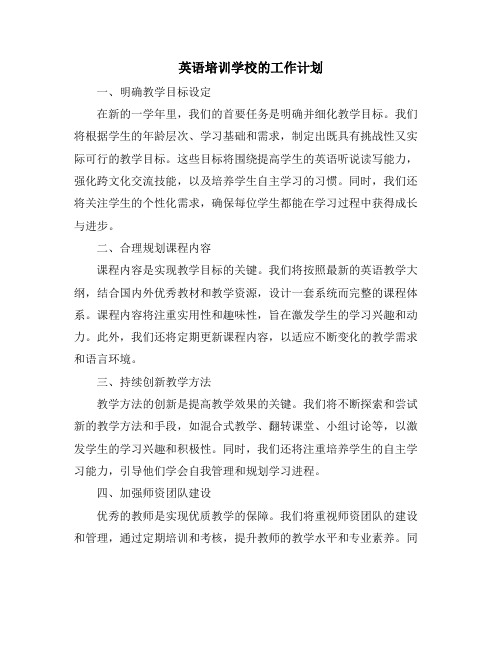
英语培训学校的工作计划一、明确教学目标设定在新的一学年里,我们的首要任务是明确并细化教学目标。
我们将根据学生的年龄层次、学习基础和需求,制定出既具有挑战性又实际可行的教学目标。
这些目标将围绕提高学生的英语听说读写能力,强化跨文化交流技能,以及培养学生自主学习的习惯。
同时,我们还将关注学生的个性化需求,确保每位学生都能在学习过程中获得成长与进步。
二、合理规划课程内容课程内容是实现教学目标的关键。
我们将按照最新的英语教学大纲,结合国内外优秀教材和教学资源,设计一套系统而完整的课程体系。
课程内容将注重实用性和趣味性,旨在激发学生的学习兴趣和动力。
此外,我们还将定期更新课程内容,以适应不断变化的教学需求和语言环境。
三、持续创新教学方法教学方法的创新是提高教学效果的关键。
我们将不断探索和尝试新的教学方法和手段,如混合式教学、翻转课堂、小组讨论等,以激发学生的学习兴趣和积极性。
同时,我们还将注重培养学生的自主学习能力,引导他们学会自我管理和规划学习进程。
四、加强师资团队建设优秀的教师是实现优质教学的保障。
我们将重视师资团队的建设和管理,通过定期培训和考核,提升教师的教学水平和专业素养。
同时,我们还将积极引进优秀人才,优化师资结构,为学生提供更加优质的教学服务。
五、优化教学资源配置教学资源的丰富与否直接影响到教学质量。
我们将加大投入,优化教学设施和设备,为学生提供更加舒适和便捷的学习环境。
同时,我们还将积极开发和利用数字化教学资源,如在线课程、教学平台等,以满足学生多样化的学习需求。
六、完善学生评估与反馈机制学生的进步和成长是我们工作的最终目标。
我们将建立起一套科学而完善的学生评估体系,通过定期测试和评估,及时了解学生的学习状况和问题。
同时,我们还将建立起有效的反馈机制,及时向学生和家长反馈学生的学习情况和进步,以便他们更好地了解和支持学生的学习。
七、拓展市场推广与合作市场推广和合作是提升学校知名度和影响力的重要手段。
小学英语暑期培训计划表
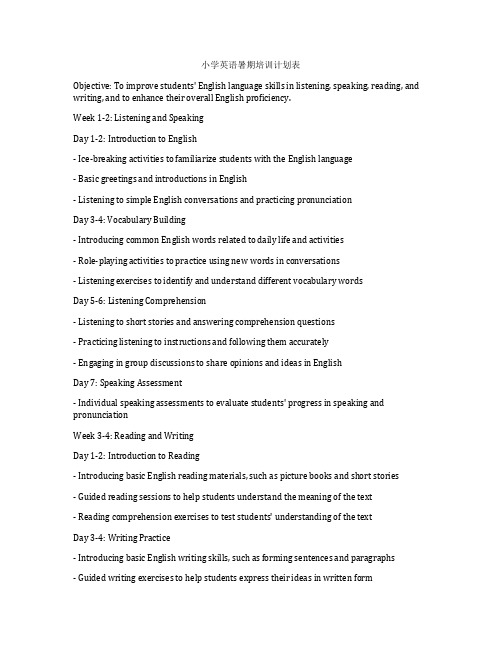
小学英语暑期培训计划表Objective: To improve students' English language skills in listening, speaking, reading, and writing, and to enhance their overall English proficiency.Week 1-2: Listening and SpeakingDay 1-2: Introduction to English- Ice-breaking activities to familiarize students with the English language- Basic greetings and introductions in English- Listening to simple English conversations and practicing pronunciationDay 3-4: Vocabulary Building- Introducing common English words related to daily life and activities- Role-playing activities to practice using new words in conversations- Listening exercises to identify and understand different vocabulary wordsDay 5-6: Listening Comprehension- Listening to short stories and answering comprehension questions- Practicing listening to instructions and following them accurately- Engaging in group discussions to share opinions and ideas in EnglishDay 7: Speaking Assessment- Individual speaking assessments to evaluate students' progress in speaking and pronunciationWeek 3-4: Reading and WritingDay 1-2: Introduction to Reading- Introducing basic English reading materials, such as picture books and short stories- Guided reading sessions to help students understand the meaning of the text- Reading comprehension exercises to test students' understanding of the textDay 3-4: Writing Practice- Introducing basic English writing skills, such as forming sentences and paragraphs- Guided writing exercises to help students express their ideas in written form- Grammar and spelling activities to reinforce writing skillsDay 5-6: Advanced Reading and Writing- Introducing longer and more complex reading materials, such as non-fiction articles and essays- Practicing summarizing and retelling the main points of a passage- Engaging in creative writing activities, such as writing short stories or poems in English Day 7: Reading and Writing Assessment- Individual reading and writing assessments to evaluate students' progress in these areas Week 5-6: English Culture and CommunicationDay 1-2: English-Speaking Countries- Introducing students to different English-speaking countries and their cultures- Exploring common traditions, festivals, and customs in these countries- Discussing the similarities and differences between students' own culture and English-speaking culturesDay 3-4: English in Daily Life- Learning about common English phrases and expressions used in daily life- Role-playing scenarios to practice using English in various real-life situations- Engaging in group discussions about everyday topics in EnglishDay 5-6: Presentation Skills- Preparing and delivering short presentations on a topic of interest in English- Practicing public speaking skills and using visual aids to support the presentation- Receiving feedback and evaluating each other's presentationsDay 7: Final Presentation and Graduation- Each student presents a final project or topic of interest in English- Graduation ceremony to celebrate students' achievements and progress in the English training program- Distributing certificates of completion to all participating studentsIn addition to the daily activities outlined above, the summer English training program will also include weekly field trips and cultural activities to provide students with opportunities to use English in real-life situations and to further immerse them in English language and culture.Overall, the primary goal of the summer English training program is to create a fun and engaging learning environment where students can improve their English language skills, build their confidence in using English, and develop a deeper understanding and appreciation for the English language and its global significance.。
英语教学工作计划表

英语教学工作计划表新的学期即将开始,为了更好地提升学生的英语水平,提高教学质量,特制定以下英语教学工作计划表:一、教学目标1、提高学生的英语综合能力,包括听、说、读、写四个方面。
确保大部分学生能够在本学期末达到课程标准所要求的相应水平。
2、培养学生的英语学习兴趣和积极性,让学生主动参与到英语学习中来。
3、帮助学生掌握有效的学习方法,提高学生的自主学习能力,为其今后的英语学习打下坚实的基础。
二、教学内容1、教材分析本学期将使用教材名称教材,该教材内容丰富,涵盖了语法、词汇、阅读、写作等多个方面。
但部分内容可能对于学生来说有一定难度,需要在教学过程中进行适当的调整和解释。
2、语法重点将重点教授一般现在时、一般过去时、现在进行时、一般将来时等基本时态,以及形容词和副词的比较级和最高级、名词的单复数等语法知识。
通过讲解、练习和实际运用,让学生熟练掌握这些语法点。
3、词汇积累要求学生掌握课本中的重点词汇,并通过阅读、背诵等方式扩大词汇量。
同时,注重词汇的实际运用,培养学生用英语表达的能力。
4、阅读与写作加强阅读训练,提高学生的阅读理解能力。
引导学生分析文章结构、理解文章主旨,并能回答相关问题。
在写作方面,注重培养学生的写作思路和规范,从简单的句子到段落,逐步提高写作水平。
三、教学方法1、情景教学法创设生动有趣的教学情境,让学生在实际情境中学习和运用英语,增强学习的趣味性和实用性。
2、互动教学法鼓励学生积极参与课堂互动,通过小组讨论、角色扮演等活动,提高学生的口语表达和合作能力。
3、任务驱动法布置各种任务,如写作、翻译、调查等,让学生在完成任务的过程中提高英语综合能力。
四、教学进度安排1、第 1-2 周复习上学期的重点知识,进行入学测试,了解学生的英语基础。
介绍本学期的教学内容和要求,让学生明确学习目标。
2、第 3-6 周教授第一单元的内容,包括词汇、语法和课文。
组织课堂活动,如对话练习、小组讨论等,巩固所学知识。
英语教学工作计划表
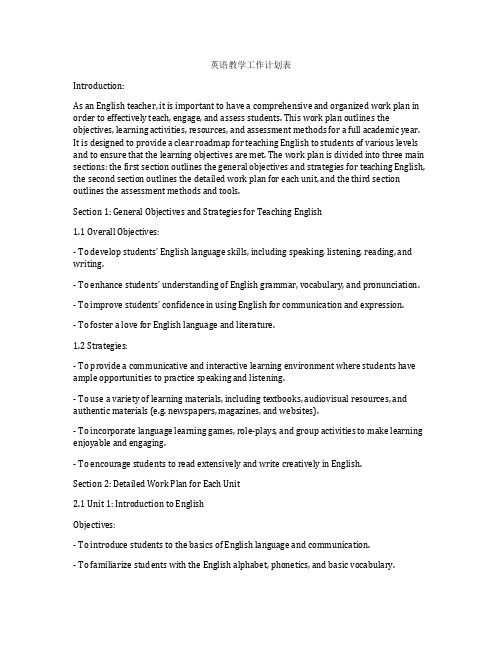
英语教学工作计划表Introduction:As an English teacher, it is important to have a comprehensive and organized work plan in order to effectively teach, engage, and assess students. This work plan outlines the objectives, learning activities, resources, and assessment methods for a full academic year. It is designed to provide a clear roadmap for teaching English to students of various levels and to ensure that the learning objectives are met. The work plan is divided into three main sections: the first section outlines the general objectives and strategies for teaching English, the second section outlines the detailed work plan for each unit, and the third section outlines the assessment methods and tools.Section 1: General Objectives and Strategies for Teaching English1.1 Overall Objectives:- To develop students’ English language skills, including speaking, listening, reading, and writing.- To enhance students’ understanding of English grammar, vocabulary, and pronunciation. - To improve students’ confide nce in using English for communication and expression.- To foster a love for English language and literature.1.2 Strategies:- To provide a communicative and interactive learning environment where students have ample opportunities to practice speaking and listening.- To use a variety of learning materials, including textbooks, audiovisual resources, and authentic materials (e.g. newspapers, magazines, and websites).- To incorporate language learning games, role-plays, and group activities to make learning enjoyable and engaging.- To encourage students to read extensively and write creatively in English.Section 2: Detailed Work Plan for Each Unit2.1 Unit 1: Introduction to EnglishObjectives:- To introduce students to the basics of English language and communication.- To familiarize students with the English alphabet, phonetics, and basic vocabulary.- To help students develop basic speaking and listening skills in English.Learning Activities:- Introduce the English alphabet and phonetics through songs and rhymes.- Teach basic English greetings, introductions, and expressions through role-plays and dialogues.- Use flashcards and picture books to teach basic English vocabulary.Resources:- English alphabet and phonetics charts.- Picture books and flashcards.- Audiovisual resources with English conversations and songs.Assessment:- Oral assessment of basic greetings and expressions.- Written assessment of basic vocabulary and spelling.2.2 Unit 2: English Grammar and Sentence StructuresObjectives:- To introduce students to the basic grammar rules of English.- To help students understand sentence structures and form simple sentences.- To provide practice in using correct grammar and sentence structures in speaking and writing.Learning Activities:- Teach basic English grammar rules and sentence structures using examples and exercises. - Practice forming and expanding simple sentences through pair work and group activities. - Use language games and quizzes to reinforce grammar rules and sentence structures. Resources:- English grammar textbooks and workbooks.- Language games and quizzes.- Examples of sentences and exercises.Assessment:- Written assessment of grammar exercises and sentence construction.- Oral assessment of using correct grammar and sentence structures in speaking.2.3 Unit 3: Developing Reading and Comprehension SkillsObjectives:- To enhance students’ reading skills and comprehension in English.- To help students understand and interpret different types of texts in English.- To develop students’ vocabulary and understanding of English through reading. Learning Activities:- Introduce various types of English texts, including stories, articles, and news reports, for reading and comprehension.- Implement reading comprehension exercises and discussions to check understanding and interpretation.- Assign reading tasks and projects that require students to use English vocabulary extensively.Resources:- Reading materials such as storybooks, articles, and news reports.- Reading comprehension exercises and worksheets.- Vocabulary building exercises and activities.Assessment:- Written assessment of reading comprehension exercises and projects.- Oral assessment of students’ understanding and interpretation of texts.2.4 Unit 4: Enhancing Speaking and Listening SkillsObjectives:- To improve students’ speaking and listening skills in English.- To provide opportunities for students to practice speaking and listening in real-life situations.- To build students’ confidence in using English for communication and expression.Learning Activities:- Conduct English conversation and speaking practice sessions through dialogues and role-plays.- Provide listening exercises and activities to improve students’ listening skills.- Organize group discussions and debates on various topics to encourage speaking and listening in English.Resources:- Audio recordings of English conversations and speeches.- Speaking and listening exercises and activities.- Topics for group discussions and debates.Assessment:- Oral assessment of speaking and listening exercises and activities.- Participation assessment in group discussions and debates.2.5 Unit 5: Writing Skills and Creative ExpressionObjectives:- To develop students’ writ ing skills and creative expression in English.- To familiarize students with different types of writing, including narrative, descriptive, and persuasive writing.- To provide practice in writing and expressing ideas in English.Learning Activities:- Teach different types of writing through examples and exercises.- Assign writing tasks and projects that require students to write creatively in English.- Provide feedback and guidance on students’ writing to improve their skills and expression. Resources:- Models of different types of writing.- Writing exercises and prompts.- Feedback and guidance on students’ writing.Assessment:- Written assessment of different types of writing and expression.- Evaluation of students’ writing skills and creativity.Section 3: Assessment Methods and Tools3.1 Continuous Assessment:- Regular quizzes and tests to assess students’ understanding and retention of English language and skills.- Formative assessments to monitor students’ progress and provide feedback for improvement.3.2 Performance Assessment:- Oral presentations and speaking tasks to assess students’ speaking and communication skills.- Written assignments and projects to assess students’ writing and creative expression skills.3.3 Final Assessment:- End-of-unit assessments to evaluate students’ overall performance and understanding of English language and skills.- Standardized tests and examinations to measure students’ proficiency and achievement in English.Conclusion:This work plan provides a comprehensive guide for teaching English to students of various levels. It outlines the objectives, learning activities, resources, and assessment methods for each unit, and it is designed to ensure that the learning objectives are met. By following this work plan, English teachers can effectively teach, engage, and assess students, and help them develop the necessary language skills and confidence in using English.。
英语教师教育培训计划表

英语教师教育培训计划表Introduction:The English language is one of the most widely spoken languages in the world and has become a common medium of communication in various professional and social settings. As such, the demand for qualified English teachers is constantly rising. To meet this demand, it is essential to provide comprehensive training and professional development opportunities for English teachers. This training program aims to equip teachers with the necessary skills and knowledge to effectively teach English to students of all ages and proficiency levels.Training Objectives:The primary objective of this training program is to enhance the teaching abilities and proficiency of English teachers and enable them to create an engaging and effective learning environment for their students. The specific training objectives include:1. Enhancing language proficiency: Improving the English language skills of teachers, including reading, writing, speaking, and listening, to ensure effective communication and instruction in the classroom.2. Developing teaching strategies: Equipping teachers with a range of teaching strategies and techniques to effectively engage students, promote language acquisition, and cater to different learning styles and abilities.3. Introducing technology in the classroom: Familiarizing teachers with the use of technology and digital resources to enhance language learning and teaching, including online tools, interactive platforms, and multimedia resources.4. Understanding language acquisition: Providing teachers with a comprehensive understanding of language acquisition theory and its application in the classroom to facilitate effective language learning.5. Fostering cultural understanding: Promoting cultural awareness and sensitivity among teachers to create an inclusive and respectful learning environment that celebrates diversity.Training Curriculum:The training curriculum is designed to cover a wide range of topics and provide teachers with practical skills and knowledge to enhance their teaching abilities. The curriculum includes the following modules:Module 1: Language Proficiency Enhancement- Reading and Comprehension- Writing Skills and Composition- Speaking and Pronunciation- Listening and ComprehensionModule 2: Teaching Methodologies- Communicative Language Teaching- Task-Based Learning- Differentiated Instruction- Classroom Management and EngagementModule 3: Technology in the Classroom- Effective Use of Digital Tools and Resources- Online Platforms for Language Learning- Multimedia Resources for Language TeachingModule 4: Language Acquisition Theory- Theories of Second Language Acquisition- Language Development Stages- Strategies for Language AcquisitionModule 5: Cultural Awareness and Sensitivity- Understanding Cross-Cultural Communication- Celebrating Diversity in the Classroom- Promoting Inclusivity and RespectTraining Methodology:The training program will utilize a variety of teaching methodologies to cater to different learning styles and preferences. These methodologies include:- Interactive Workshops: Engaging workshops focusing on practical teaching strategies and language skill development.- Collaborative Learning: Group activities and collaborative projects to promote peer learning and knowledge sharing.- Multimedia Presentations: Visual and multimedia resources to enhance understanding and retention of key concepts.- Simulated Teaching Practice: Opportunities for teachers to practice teaching techniques and receive constructive feedback.- Reflective Assignments: Self-reflection and journaling to facilitate the integration of new knowledge and skills.Training Resources:The training program will provide access to a wide range of resources to support the learning and development of English teachers. These resources include:- Textbooks and Reference Materials: Essential reading materials and reference books on language teaching and learning.- Online Learning Platforms: Access to online courses, resources, and tools to support teachers' professional development.- Multimedia Resources: Audiovisual materials, online videos, and interactive resources for language teaching and learning.- Teaching Aids and Materials: Supplementary teaching aids and materials to support the implementation of effective teaching strategies.Training Schedule:The training program will be conducted over a period of six months, with a combination of in-person workshops, online modules, and self-directed learning activities. The schedule is as follows:Month 1-2: Language Proficiency Enhancement- Reading and Comprehension Workshop- Writing Skills and Composition Workshop- Speaking and Pronunciation Workshop- Listening and Comprehension WorkshopMonth 3-4: Teaching Methodologies- Communicative Language Teaching Workshop- Task-Based Learning Workshop- Differentiated Instruction Workshop- Classroom Management and Engagement WorkshopMonth 5: Technology in the Classroom- Effective Use of Digital Tools and Resources Workshop- Online Platforms for Language Learning Workshop- Multimedia Resources for Language Teaching WorkshopMonth 6: Language Acquisition Theory and Cultural Awareness- Theories of Second Language Acquisition Workshop- Cultural Awareness and Sensitivity Workshop- Simulated Teaching Practice and ReflectionAssessment and Evaluation:The training program will incorporate various assessment and evaluation methods to measure the effectiveness and impact of the training. These methods include:- Pre and Post-Training Language Proficiency Assessment- Classroom Observation and Evaluation of Teaching Practices- Reflective Journals and Self-Assessment- Feedback and Evaluation SurveysConclusion:The English Teacher Training Program is designed to provide comprehensive training and professional development opportunities for English teachers, equipping them with the necessary skills and knowledge to effectively teach English to students of all ages and proficiency levels. By enhancing language proficiency, teaching methodologies, technology integration, language acquisition theory, and cultural awareness, this training program aims to enable teachers to create engaging and effective learning environments that promote language acquisition and cultural understanding.。
英语培训学校教学计划教学计划
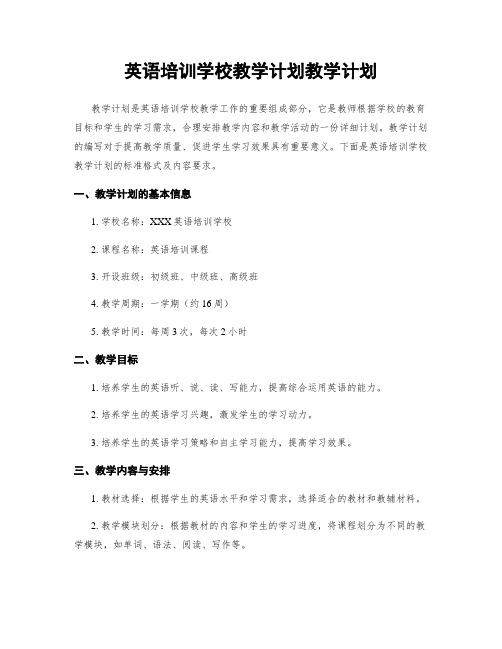
英语培训学校教学计划教学计划教学计划是英语培训学校教学工作的重要组成部分,它是教师根据学校的教育目标和学生的学习需求,合理安排教学内容和教学活动的一份详细计划。
教学计划的编写对于提高教学质量、促进学生学习效果具有重要意义。
下面是英语培训学校教学计划的标准格式及内容要求。
一、教学计划的基本信息1. 学校名称:XXX英语培训学校2. 课程名称:英语培训课程3. 开设班级:初级班、中级班、高级班4. 教学周期:一学期(约16周)5. 教学时间:每周3次,每次2小时二、教学目标1. 培养学生的英语听、说、读、写能力,提高综合运用英语的能力。
2. 培养学生的英语学习兴趣,激发学生的学习动力。
3. 培养学生的英语学习策略和自主学习能力,提高学习效果。
三、教学内容与安排1. 教材选择:根据学生的英语水平和学习需求,选择适合的教材和教辅材料。
2. 教学模块划分:根据教材的内容和学生的学习进度,将课程划分为不同的教学模块,如单词、语法、阅读、写作等。
3. 教学进度安排:根据教学周期和教学模块的内容,合理安排每个教学模块的教学时间和进度。
4. 教学方法与活动设计:采用多种教学方法,如听说训练、角色扮演、小组合作等,激发学生的学习兴趣和参与度。
5. 课堂作业设计:每节课安排适量的课堂作业,巩固学生的学习内容,并及时批改和反馈。
四、教学评估与反馈1. 评估方式:采用多种评估方式,如课堂表现评价、小组合作评价、期中期末考试等,全面评估学生的学习情况。
2. 评估标准:明确评估标准,根据学生的学习目标和教学要求,制定评分细则,确保评估的客观公正性。
3. 反馈与辅导:根据评估结果,及时给予学生学习反馈和个性化辅导,帮助学生改进学习方法和提高学习效果。
五、教学资源与支持1. 教学设备:确保教室内有音响设备、投影仪等教学设备,以便教师进行多媒体教学。
2. 教学资料:为教师提供教学所需的教材、教辅材料和其他相关资料,支持教师的教学工作。
英语师资培训计划表模板

英语师资培训计划表模板IntroductionIn order to improve the quality of English education in our school, we have developed a comprehensive English teacher training program. This program aims to enhance the English teaching skills of our teachers, update their knowledge of the English language, and provide them with new teaching strategies and techniques.ObjectiveThe main objective of this training program is to help our English teachers become more effective and competent in teaching English language and literature. Our goal is to improve the overall English proficiency of our students and help them become better communicators and users of the English language.Program OutlineThe English teacher training program will consist of multiple training modules, workshops, seminars, and online courses. The program will be divided into several stages, each focusing on a specific aspect of English teaching. The topics covered will include language skills, teaching methods, assessment, and technology integration.Stage 1: Language ProficiencyIn this stage, teachers will undergo a language proficiency test to assess their English language skills. Based on the results, teachers will be provided with targeted language training to improve their proficiency in English. This training will cover various aspects of the English language, including grammar, vocabulary, pronunciation, and speaking skills.Stage 2: Pedagogical TrainingThis stage will focus on teaching methods and strategies for English language instruction. Teachers will be introduced to new teaching techniques, such as communicative language teaching, task-based learning, and project-based learning. They will also learn how to design effective lesson plans, create engaging learning activities, and use technology in the classroom.Stage 3: Assessment and FeedbackIn this stage, teachers will learn about different types of assessment tools and techniques for evaluating students' English proficiency. They will be trained in how to provide constructive feedback to students, identify their strengths and weaknesses, and track their progress. Teachers will also learn how to use assessment data to adjust their teaching strategies and improve student learning outcomes.Stage 4: Technology IntegrationIn today's digital world, it is essential for teachers to be proficient in using technology in the classroom. In this stage, teachers will be trained in how to integrate technology tools and resources into their English language instruction. They will learn about educational software, online resources, multimedia materials, and interactive whiteboards that can be used to enhance their teaching and engage students.Evaluation and FeedbackThroughout the training program, teachers' progress will be monitored and evaluated through regular assessments, classroom observations, and feedback from students and colleagues. This feedback will be used to identify areas for improvement and tailor the training program to meet the specific needs of our English teachers.ConclusionBy implementing this comprehensive English teacher training program, we aim to equip our teachers with the knowledge, skills, and resources they need to deliver high-quality English language instruction. We believe that this program will have a positive impact on our students' English language proficiency and help them succeed in their academic and professional pursuits. We are committed to providing ongoing support and professional development opportunities for our English teachers to ensure that they continue to grow and excel in their teaching careers.。
英语培训学校教学计划教学计划
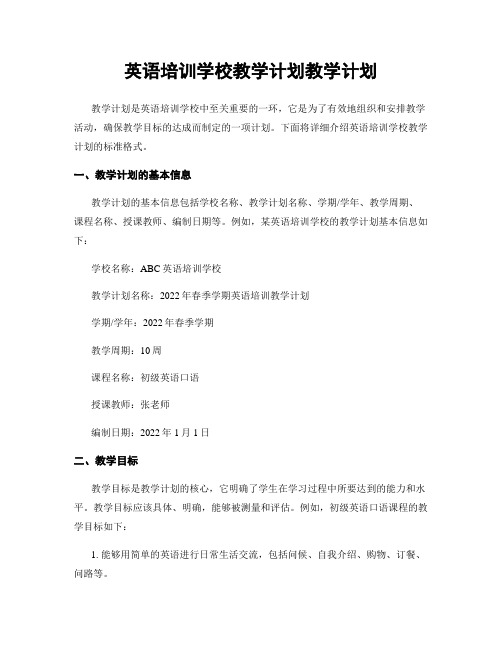
英语培训学校教学计划教学计划教学计划是英语培训学校中至关重要的一环,它是为了有效地组织和安排教学活动,确保教学目标的达成而制定的一项计划。
下面将详细介绍英语培训学校教学计划的标准格式。
一、教学计划的基本信息教学计划的基本信息包括学校名称、教学计划名称、学期/学年、教学周期、课程名称、授课教师、编制日期等。
例如,某英语培训学校的教学计划基本信息如下:学校名称:ABC英语培训学校教学计划名称:2022年春季学期英语培训教学计划学期/学年:2022年春季学期教学周期:10周课程名称:初级英语口语授课教师:张老师编制日期:2022年1月1日二、教学目标教学目标是教学计划的核心,它明确了学生在学习过程中所要达到的能力和水平。
教学目标应该具体、明确,能够被测量和评估。
例如,初级英语口语课程的教学目标如下:1. 能够用简单的英语进行日常生活交流,包括问候、自我介绍、购物、订餐、问路等。
2. 能够理解并运用基本的英语语法和词汇,构建简单的句子和对话。
3. 能够熟练运用英语口语表达自己的观点和意见,并能够参与简单的小组讨论。
三、教学内容和教学方法教学内容是指在教学过程中所要涵盖的知识点、技能和能力。
教学方法是指教师在教学过程中采用的具体教学手段和方法。
例如,初级英语口语课程的教学内容和教学方法如下:1. 教学内容:- 日常生活用语:问候、自我介绍、购物、订餐、问路等。
- 基本的英语语法和词汇:动词、名词、形容词、副词等。
- 口语表达技巧:发音、语调、流利度、表达观点和意见等。
2. 教学方法:- 交际法:通过模拟真实情境,让学生进行口语对话练习。
- 听说训练:通过听力练习和口语训练,提高学生的听力理解和口语表达能力。
- 小组讨论:组织学生进行小组讨论,培养学生的合作能力和表达能力。
四、教学活动和教学资源教学活动是指在教学过程中具体的教学任务和活动安排,教学资源是指教师在教学过程中所需要的教学材料和工具。
例如,初级英语口语课程的教学活动和教学资源如下:1. 教学活动:- 角色扮演:让学生分角色进行对话练习,提高口语表达能力。
幼师英语培训计划表模板

幼师英语培训计划表模板培训目标:帮助幼师提高英语运用能力,提升教学质量和服务水平。
培训时间:8周培训方式:面授讲座、小组讨论、实践活动、教学观摩等形式培训内容:第一周1. 英语基础知识介绍- 英语语音系统- 基本语法知识- 常用英语词汇2. 幼儿英语教育理念- 幼儿英语教学的特点和重要性- 幼儿英语教学的基本原则3. 幼儿英语教学方法介绍- 游戏教学法- 情景教学法- TPR教学法第二周1. 英语语音与发音训练- 介绍英语元音、辅音的发音规则- 练习常用音标的发音2. 幼儿英语课堂设计- 课程设置和结构- 教学活动设计3. 幼儿英语教材选用- 常用幼儿英语教材介绍- 如何选择和使用教材第三周1. 幼儿英语课堂管理- 教室环境营造- 课堂活动组织2. 幼儿英语口语表达- 常用口语表达- 讲故事、唱歌等口语表达技巧3. 课程评估与反馈- 如何进行课程评估- 如何给予学生积极的反馈第四周1. 幼儿英语教学资源搜集- 网络资源、教具、游戏等- 如何开发自己的教学资源2. 幼儿英语教学案例分享- 分析经典教学案例- 思考如何应用到自己的教学中3. 教学观摩- 观摩其他幼师的优秀课堂教学第五周1. 幼儿英语听力训练- 听力训练的重要性- 如何进行幼儿英语听力训练2. 口语练习- 口语练习游戏- 提高幼儿英语口语能力的方法3. 实践教学- 模拟教学课堂- 进行教学实践活动第六周1. 幼儿英语阅读训练- 幼儿英语阅读教学特点- 如何进行幼儿英语阅读训练2. 写作训练- 幼儿英语写作教学特点- 如何进行幼儿英语写作训练3. 教学反思- 分析自己的教学过程- 思考如何提高教学效果第七周1. 评估测试- 对培训内容进行总结- 进行培训结束考核2. 幼儿英语教学实践分享- 分享培训期间的教学实践心得- 交流教学经验3. 毕业典礼- 颁发培训结业证书第八周1. 毕业实习- 将所学知识应用到实际教学中- 指导老师进行实际教学2. 教学反馈- 对毕业实习过程进行反馈- 提出改进建议3. 结业总结- 汇总培训效果- 总结培训经验培训师资:拥有丰富教学经验和专业知识的英语教育专家培训评估:每周进行课程评估和学员反馈,及时调整培训内容和方式备注:以上为培训计划表范例,具体培训内容和时间安排可根据实际情况进行调整。
英语培训项目计划表

英语培训项目计划表1. IntroductionThe English Training Program is designed to help participants improve their English language skills in speaking, listening, reading, and writing. This program aims to provide comprehensive training to enhance proficiency and confidence in using the English language for both personal and professional purposes.2. Program Objectives- To improve participants’ speaking and listening skills in English- To enhance participants’ reading and writing skills in English- To build confidence in using the English language for communication- To provide cultural insights and understanding of English-speaking countries- To prepare participants for English language proficiency exams (e.g. TOEFL, IELTS)3. Target ParticipantsThe target participants for this program are individuals who have basic proficiency in English and are looking to advance their language skills. This program is suitable for working professionals, students, and anyone who wants to improve their English communication abilities.4. Program DurationThe English Training Program will run for a total of 12 weeks, with classes held twice a week for 2 hours each session. The program will consist of a total of 24 sessions, providing a comprehensive coverage of the English language skills.5. Program CurriculumThe program will cover the following topics and skills:- Speaking and pronunciation practice- Listening comprehension and communication exercises- Reading comprehension and vocabulary building- Writing skills and composition practice- English grammar and sentence structure- Cultural understanding and language usage in real-life situations6. Teaching MethodologyThe program will utilize a variety of teaching methods to engage participants and enhance their learning experience. This will include interactive lectures, group discussions, role-playing exercises, multimedia learning materials, and language immersion activities.7. Program Materials and ResourcesParticipants will be provided with a range of materials and resources to support their learning, including:- Textbooks and workbooks- Audio and video resources for listening comprehension- Online learning platforms for additional practice and assessments- Language learning apps and tools for continued practice outside of classes8. Program AssessmentParticipants will be assessed throughout the program to track their progress and identify areas for improvement. Assessments will include written tests, oral presentations, listening comprehension exercises, and participation in group activities.9. Program CertificationUpon successful completion of the English Training Program, participants will be awarded a certificate of proficiency to recognize their achievement and dedication to improving their English language skills.10. Program InstructorsThe program will be facilitated by experienced and qualified English language instructors who are native or proficient speakers of the language. Instructors will be selected based on their teaching experience, language proficiency, and ability to engage and motivate participants.11. Program Fees and RegistrationParticipants will be required to pay a program fee to enroll in the English Training Program. Early registration discounts and scholarships may be available for eligible individuals. Registration will be conducted online and in-person at designated program offices.12. Program ScheduleThe program is scheduled to commence on [start date] and conclude on [end date]. Classes will be held on [days of the week] from [start time] to [end time] at the program location.13. Program Support and FeedbackParticipants will have access to program coordinators and support staff for any inquiries, feedback, or assistance during the program. Regular feedback sessions and surveys will be conducted to gather input from participants and continuously improve the program.14. Program BenefitsThe English Training Program aims to provide the following benefits to participants:- Improved English language proficiency for personal and professional use- Enhanced communication skills for increased confidence- Preparation for English proficiency exams and certification- Cultural understanding and appreciation of English-speaking countries- Networking opportunities with fellow participants and language enthusiasts15. ConclusionThe English Training Program is designed to provide a holistic and engaging learning experience for participants to improve their English language skills. With a comprehensive curriculum, experienced instructors, and a supportive learning environment, the program aims to empower individuals to effectively communicate and excel in the English language. *Please note that the information provided in this program plan is subject to change and may be customized based on the specific needs and requirements of the participants and stakeholders.。
培训计划表英语版
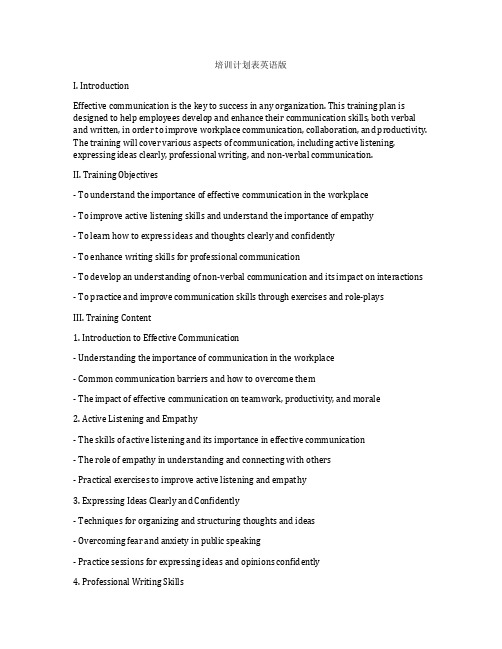
培训计划表英语版I. IntroductionEffective communication is the key to success in any organization. This training plan is designed to help employees develop and enhance their communication skills, both verbal and written, in order to improve workplace communication, collaboration, and productivity. The training will cover various aspects of communication, including active listening, expressing ideas clearly, professional writing, and non-verbal communication.II. Training Objectives- To understand the importance of effective communication in the workplace- To improve active listening skills and understand the importance of empathy- To learn how to express ideas and thoughts clearly and confidently- To enhance writing skills for professional communication- To develop an understanding of non-verbal communication and its impact on interactions - To practice and improve communication skills through exercises and role-playsIII. Training Content1. Introduction to Effective Communication- Understanding the importance of communication in the workplace- Common communication barriers and how to overcome them- The impact of effective communication on teamwork, productivity, and morale2. Active Listening and Empathy- The skills of active listening and its importance in effective communication- The role of empathy in understanding and connecting with others- Practical exercises to improve active listening and empathy3. Expressing Ideas Clearly and Confidently- Techniques for organizing and structuring thoughts and ideas- Overcoming fear and anxiety in public speaking- Practice sessions for expressing ideas and opinions confidently4. Professional Writing Skills- The basics of professional writing, including structure, clarity, and conciseness- Writing effective emails, memos, and reports- Proofreading and editing techniques for error-free communication5. Non-Verbal Communication- Understanding body language and its impact on communication- Facial expressions, gestures, and posture- Practicing non-verbal communication in different scenariosIV. Training MethodsThe training will use a variety of methods to engage participants and ensure effective learning:- Interactive discussions and group activities to encourage participation and sharing of experiences- Role-plays and simulations to practice communication skills in realistic scenarios- Individual and group exercises to develop and improve specific communication skills - Real-life case studies to analyze and learn from successful and unsuccessful communication examples- Feedback and coaching on individual performance and improvement areasV. Training ScheduleThe training program will be conducted over a period of two weeks, with a total of 10 sessions, each lasting for 2 hours. The schedule is as follows:Session 1: Introduction to Effective Communication- Understanding the importance of effective communication in the workplace- Identifying common communication barriers and their impact- Group discussion and sharing of personal experiencesSession 2: Active Listening and Empathy- The skills of active listening and its importance in communication- The role of empathy in understanding and connecting with others- Practice exercises for improving active listening skillsSession 3: Expressing Ideas Clearly and Confidently- Techniques for organizing and structuring thoughts and ideas- Overcoming fear and anxiety in public speaking- Practice sessions for expressing ideas and opinions confidentlySession 4: Professional Writing Skills- Basics of professional writing, including structure, clarity, and conciseness- Writing effective emails, memos, and reports- Proofreading and editing techniques for error-free communicationSession 5: Non-Verbal Communication- Understanding body language and its impact on communication- Facial expressions, gestures, and posture- Practice exercises for non-verbal communication in different scenariosSession 6: Role-plays and Simulations- Role-plays and simulations to practice communication skills in realistic scenarios - Feedback and coaching on individual performanceSession 7: Group Activities and Exercises- Group activities to develop and improve specific communication skills- Practice exercises for active listening, empathy, and non-verbal communication Session 8: Real-Life Case Studies- Analyzing and learning from successful and unsuccessful communication examples - Group discussions on applying lessons learned to the workplaceSession 9: Individual Practice and Coaching- Individual practice of communication skills with coaching and feedback- Identifying personal improvement areas and setting goals for improvement Session 10: Wrap-Up and Evaluation- Review of key learnings and takeaways from the training- Feedback session for participants to share their thoughts and suggestions for improvement- Evaluating the effectiveness of the training program and identifying areas for future developmentVI. Training Materials- PowerPoint presentations for each session- Handouts and worksheets for exercises and activities- Case studies and examples for analysis and discussion- Role-play scenarios and simulations for practiceVII. Evaluation PlanThe effectiveness of the training program will be evaluated through various methods:- Pre-training and post-training assessments to measure improvements in communication skills- Feedback forms after each session to capture participant insights and suggestions for improvement- Observations and feedback from trainers and coaches during practice sessions and role-plays- Post-training surveys to gather overall feedback on the training programVIII. ConclusionEffective communication is essential for success in any organization. This training plan is designed to help employees develop and enhance their communication skills, both verbal and written, in order to improve workplace communication, collaboration, and productivity. By focusing on active listening, empathy, expressing ideas clearly, professional writing, and non-verbal communication, the training program aims to equip participants with the tools and techniques to communicate effectively in any professional setting. Through a variety of interactive and engaging methods, participants will have the opportunity to practice and improve their communication skills and contribute to a more positive and productive work environment.。
- 1、下载文档前请自行甄别文档内容的完整性,平台不提供额外的编辑、内容补充、找答案等附加服务。
- 2、"仅部分预览"的文档,不可在线预览部分如存在完整性等问题,可反馈申请退款(可完整预览的文档不适用该条件!)。
- 3、如文档侵犯您的权益,请联系客服反馈,我们会尽快为您处理(人工客服工作时间:9:00-18:30)。
编号:YB-JH-0819
( 工作计划)
部门:_____________________
姓名:_____________________
日期:_____________________
WORD文档/ A4打印/ 可编辑
英语培训学校工作计划表格
(新版)
Frequently formulating work plans can make people’s life, work and study more regular, and develop good habits, which is a habit necessary for success in doing things
英语培训学校工作计划表格(新版)
摘要:经常制订工作计划,可以使人的生活、工作和学习比较有规律性,养成良好的习惯,因为习惯了制订工作计划,于是让人变得不拖拉、不懒惰、不推诿、不依赖,养成一种做事成功必须具备的习惯。
本内容可以放心修改调整或直接使用。
一、指导思想
海南师范大学外语系以服务少数民族和贫困地区为宗旨,在当
地教育局的统一部署与安排下,重组我系英语学科教师教育资源与
中学英语教学实践资源,与琼中县基地学校共同建立起为期一年的
周末流动师资培训学院,计划在琼中县培养10-12名研究型初中英
语骨干教师,帮助他们更有效地更新教育教学理念和专业知识,提
高学科教育理论修养和教学研究能力,并以他们为种子队员,推动
教师所在学校的校本教师培训与反思性实践活动的开展,促进琼中
县初中英语教师队伍的专业化进程,实现琼中县英语学科课程改革
和海师大外语系英语学科教学研究的双赢目标,英语培训学校工作
计划。
二、培训目标
研究型骨干教师应该具有较强的英语学科教学能力和愿意对英
语教学进行反思性实践研究的积极态度与基本技能,包括:
1、能够清楚地描述自己教学的目标、具体过程、结果和存在的教学问题;
2、对个人教学有自我监控的意识与能力(包括能够有效观察课堂、记录、反思和讲述自己的教学决策思路);
3、能够对教学进行质量评价、分析和诊断,并能够处理自己的教学问题;
4、能够对教师的课堂教学行为进行内容分析、学会对教学进行比较与归纳;
5、能够用有关语言、学习、教学等相关的外语教学理论对教师教学行为背后的原因进行推理和解释;
6、习惯于与其他同伴教师进行反思性交流与合作;
7、对自己的教学问题或某种课堂现象能够采用正确方式进行调查;
8、能够对自己的调查数据进行处理和对调查结果进行讨论,并能将自己的调查过程与结论撰写成行动研究报告。
三、培训内容
海师大周末流动师资培训学院英语学科从06年12月开始至07年12月结束,在琼中县进行为期两个学期的周末培训活动。
本培训着眼于提高教师个人对外语教与学的个人理解,发展教师自身的专业发展意识与对个人教学行为与思维过程进行研究的意识。
为此,教师将以所在学校教研小组为单位学会开展经常性的教学反思与交流活动,以提高其自我专业发展的技术和能力,特别是进行教学行动研究所需要的各种方法、手段与技巧,并通过这种互助性的(Peer-Support)小组研究活动,在交互性的学习与研究中学会总结和扩展自己的教学实践知识,为教师专业的终生发展打好坚实的基矗
四、培训与检测方式
1、主题性集中培训
每次集中培训都以一个教学主题为中心进行课堂教学分析与研讨活动,邀请本县全体初中英语教师共同参与,一方面有利于促进全县初中英语教师专业化的整体进程,同时为研究型骨干教师的专
业发展提供良好的教师教育氛围与同伴教师之间相互支持和交流合作的人文环境。
凡积极、认真参加每次主题培训活动、并能大胆发表个人意见的教师均可获5学分。
2、自主性记录培训
每位研究型骨干教师必须填写专业自查表,包括:(1)本校英语教育的水平、条件和问题;(2)本人从教英语的历史及特长;(3)本人参加培训的需求与打算;每次训练后都要撰写训练笔记,总结收获体会;每次校本的小组反思后都要写教学反思日志;培训期间还要通过电子邮箱和写博客的方式与指导教师和其他学员进行交流,每周至少一次。
凡认真完成以上学习与反思记录工作的教师均可获5学分。
3、任务性检测培训:
每位研究型骨干教师必须完成以下专业知识与技能、课堂教学研究和教学行动研究三项专业培训任务,以便进行培训目标的全面检测,凡达标者可获10学分,执行细节如下:
(1)专业知识与技能培训的任务与检测:
每位研究型骨干教师必须在基地学校或所在学校演示1-2节公
开课,清楚描述自己的教学目标、过程、结果和所存在的教学问题,接受其他教师的评价与建议,并写出自己公开课的反思报告。
完成公开课任务的教师可获1学分,优质课可加0.5学分,能够在反思报告中清楚描述和分析自己的教学行为、思想过程的教师可再加1学分(共2.5学分)。
(2)课堂教学研究培训的任务与检测:
每位研究型骨干教师至少要将自己的1-2节课进行录音,转录成课堂话语文本资料,以便对自己的课堂教学的内容进行归纳性分析,并在指定时间与地点向其他教师报告自己的分析结论。
完成分析文本的教师可获1学分,在分析报告中能正确归纳自己教学行为要点的教师可加1学分,能够在互助组内推广该课堂教学分析方法的教师可再加0.5学分,(共2.5学分)。
(3)教学行动研究的培训任务与检测:
每位研究型骨干教师必须结合自己的教学实际提出至少1个教学行动调研方案,并写出相关的调查报告和行动研究报告,完成该任务的教师可获1学分,在研究报告中能正确运用研究方法和手段
调查问题、处理数据、进行调查结果讨论的教师可加1学分,能够根据自己的研究结论进一步进行后续研究、并在互助组内推广该研究方法的教师可再加0.5学分,(共2.5学分)。
教师在培训期间所撰写的其他教育教学改革论文、实验报告或相关论文、教学实践指导报告等都可分别获1、2或2.5学分。
以上各项培训的学分为20。
凡获18学分以上(含18学分)的教师,评估总成绩为优秀、凡获得17-15分的教师为合格,获15分以下的教师为不合格。
评价考核工作由培训导师,研讨小组,及教师本人共同完成。
流动学院英语学科工作站将为每位教师统一建立研究型骨干教师专业发展个人档案(包括纸质与电子两种文本)。
评价以量化记分和定性评价相结合,以利于教师的继续发展与本流动学院对我省贫困地区外语教师教育现状的深入调查和研究。
凡检测合格的教师将获得海南师范大学流动学院所颁发的相关证书,优秀的骨干教师将获得海南师范大学外语系师范生英语教育实践导师的荣誉称号,他们还可以参与流动学院对其他县的轮训服
务工作或师范生的教育实习指导工作。
五、协作管理机构
琼中县教育局、琼中县教师培训中心、琼中县中基地学校与海南师范大学外语系共同组建海南师范大学周末流动师资培训学院英语学科工作站,负责以上专业训练活动的组织协调与行政管理工作,主要由基地学校和海南师范学院外语系具体实施训练计划,包括指导教师的聘用与管理、各种训练活动的组织、博客网站的建设、学员学分的确认、以及学员专业档案的建立等。
这里填写您的公司名字
Fill In Your Business Name Here。
